Abstract
1. The recapture and re-use of choline formed by the hydrolysis of released acetylcholine (ACh) was studied in the superior cervical ganglion of the cat using radioactive tracer techniques. The ganglion's ACh store was labelled by perfusion, during preganglionic nerve stimulation, with Krebs solution containing [3H]choline.
2. Preganglionic stimulation (5 Hz for 20 min) of ganglia containing [3H]ACh released similar amounts of radioactivity when perfusion was with neostigmine—choline—Krebs or with hemicholinium—Krebs. This indicated that neostigmine does not increase transmitter release.
3. The amount of radioactivity collected from stimulated ganglia during perfusion with choline—Krebs was 39% of the amount of radioactivity collected during perfusion with medium containing neostigmine or hemi-cholinium. This difference in release was almost (85%) accounted for at the end of the experiment by extra radioactive ACh in the ganglia perfused with choline—Krebs. It is concluded that during preganglionic nerve stimulation approximately 50-60% of endogenously produced choline is recaptured for ACh synthesis; thus, during activity preganglionic nerve terminals appear selectively to accumulate choline.
4. However, chronically decentralized ganglia accumulated as much choline as did acutely decentralized ganglia, and this was interpreted as indicating that at rest preganglionic nerve terminals do not selectively accumulate choline.
5. Increased exogenous choline concentration increased the amount of radioactivity collected during nerve stimulation in the absence, but not the presence, of an anticholinesterase agent. The spontaneous efflux of radioactivity was little affected by changes in external choline levels. It is concluded that exogenous choline and choline made available from released transmitter compete for uptake into nerve terminals.
Full text
PDF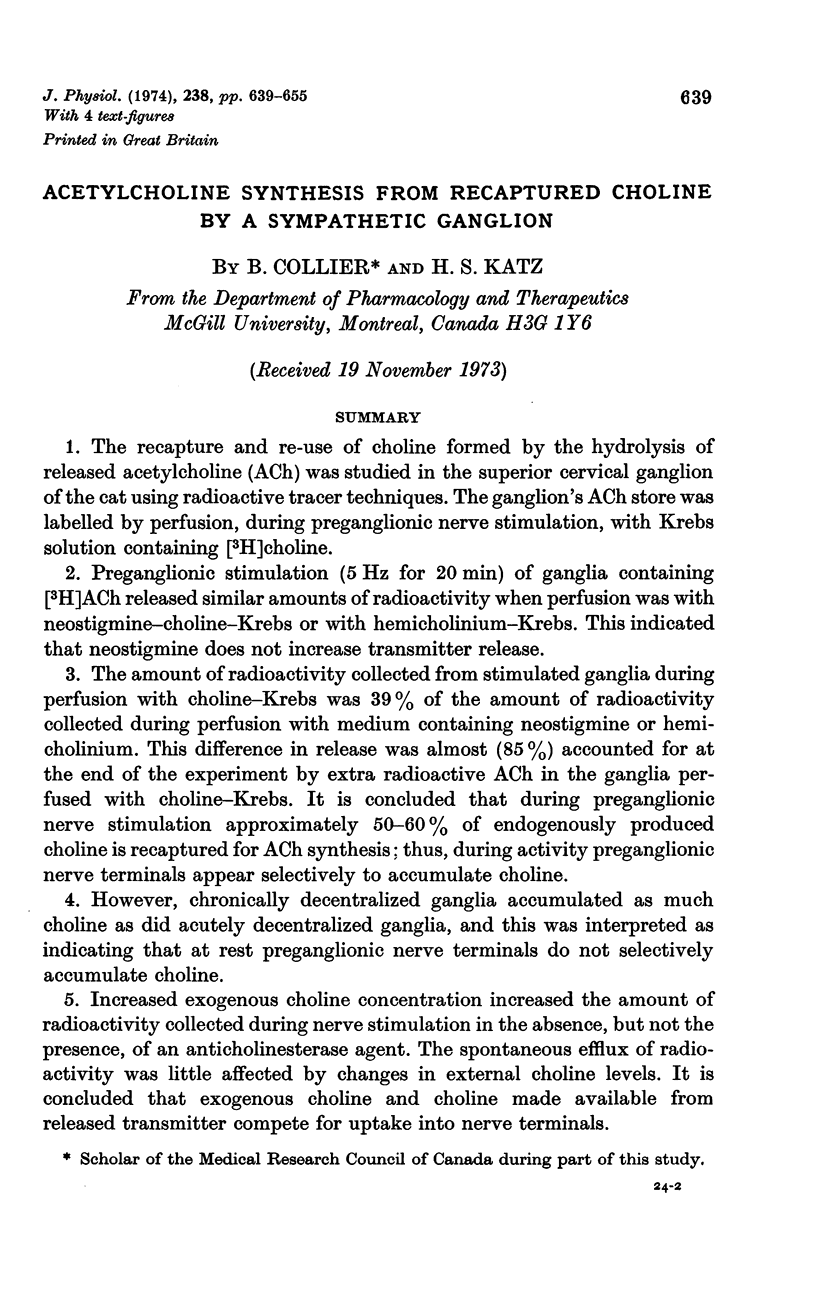
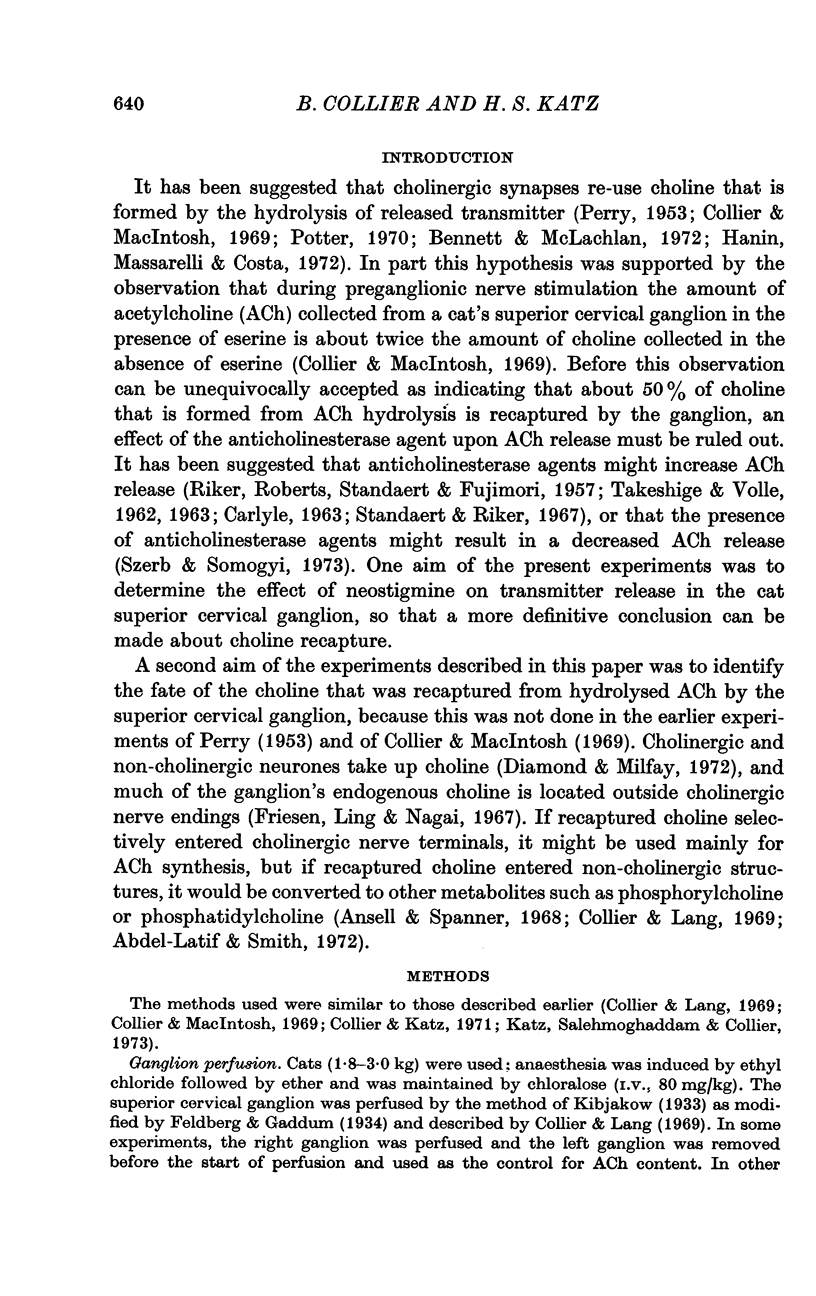
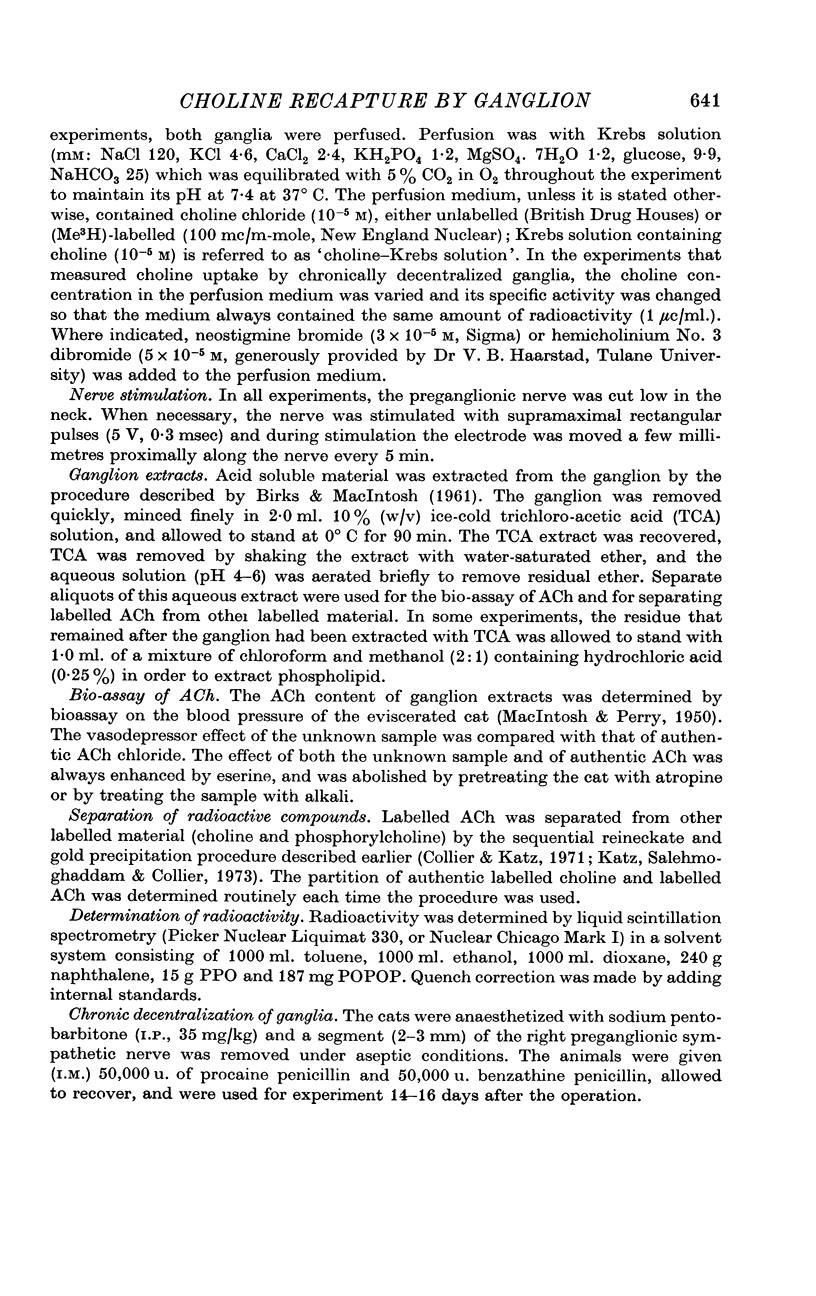
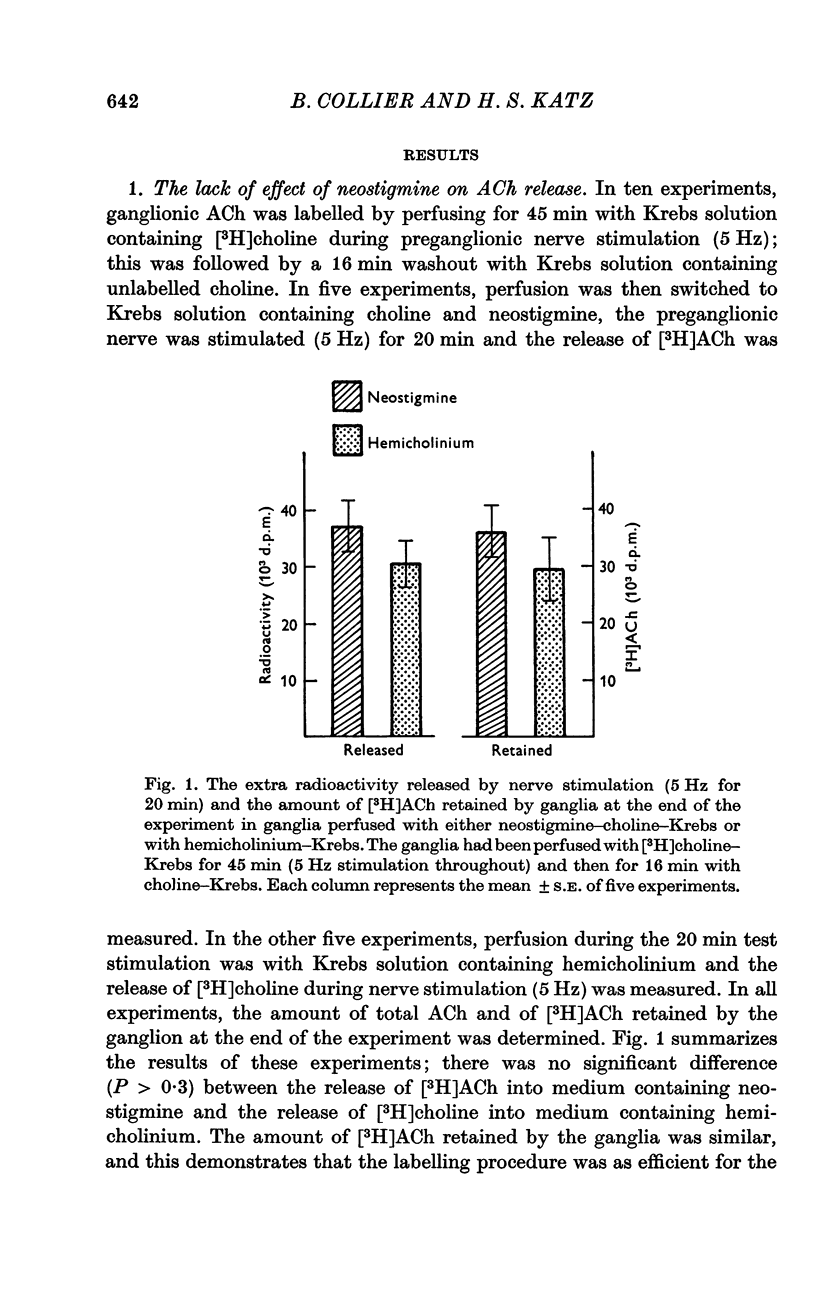
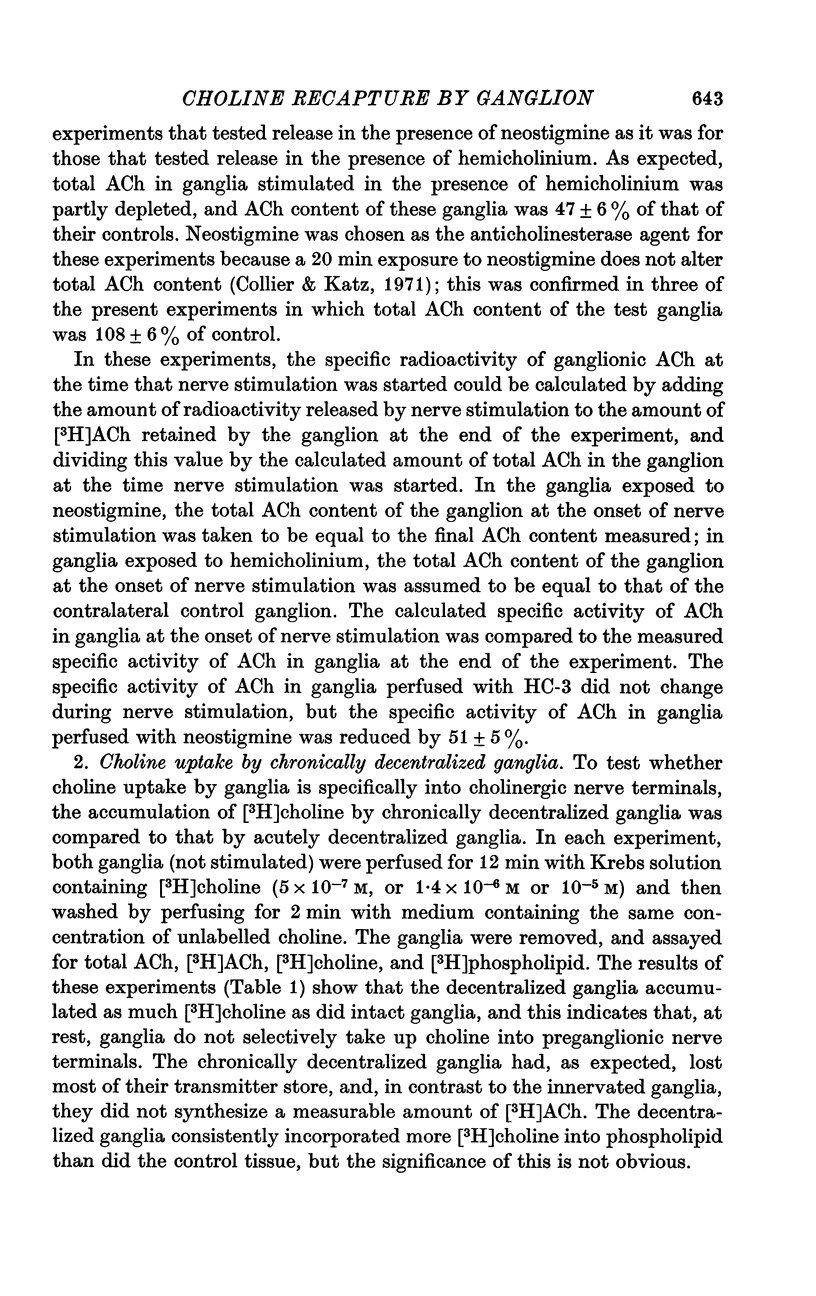
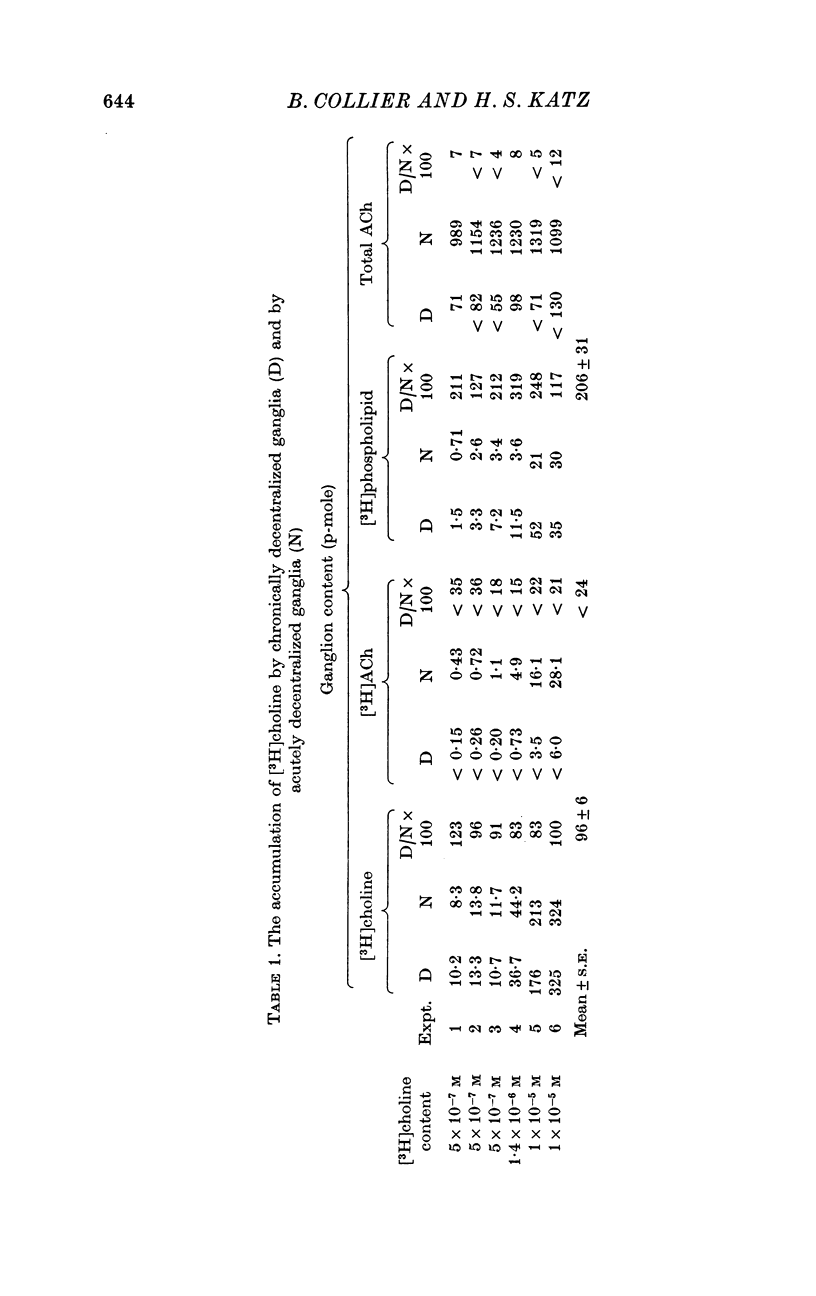
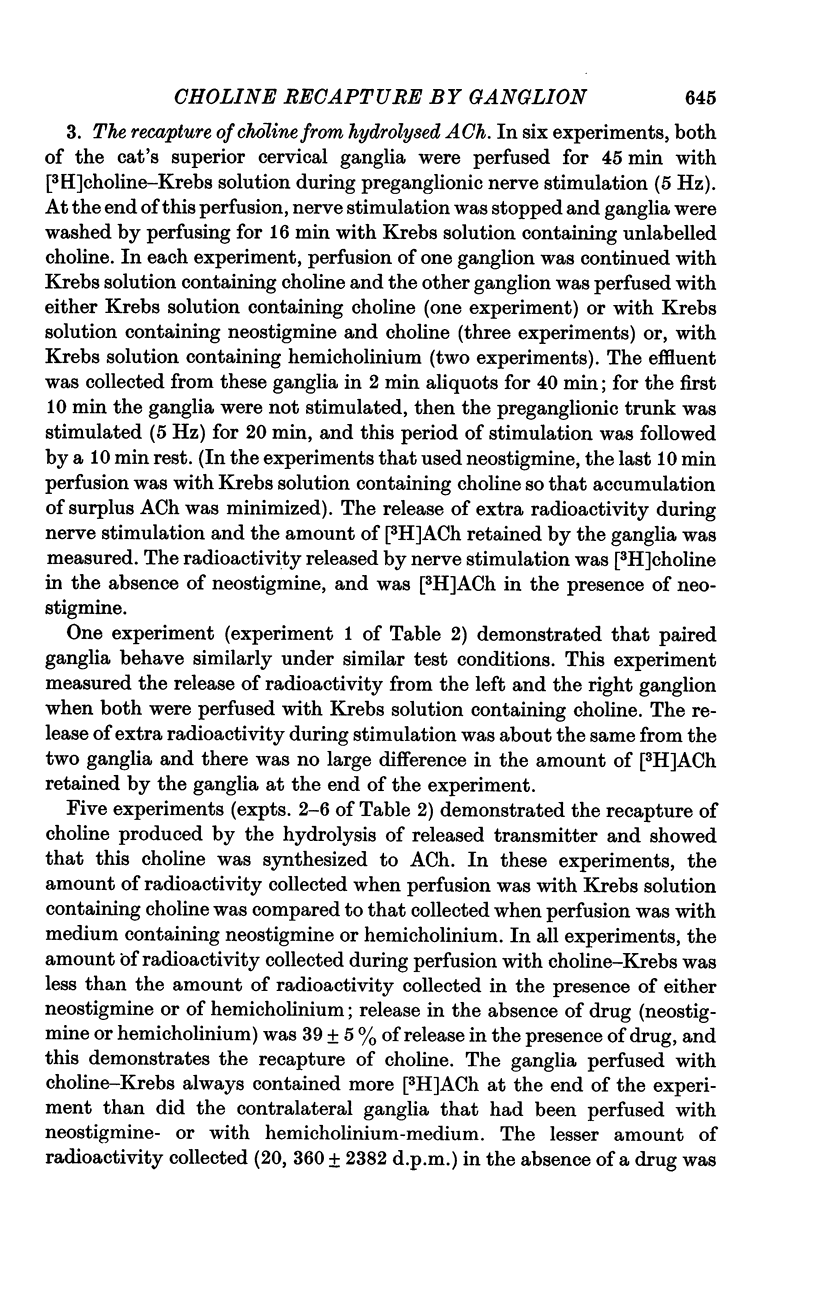
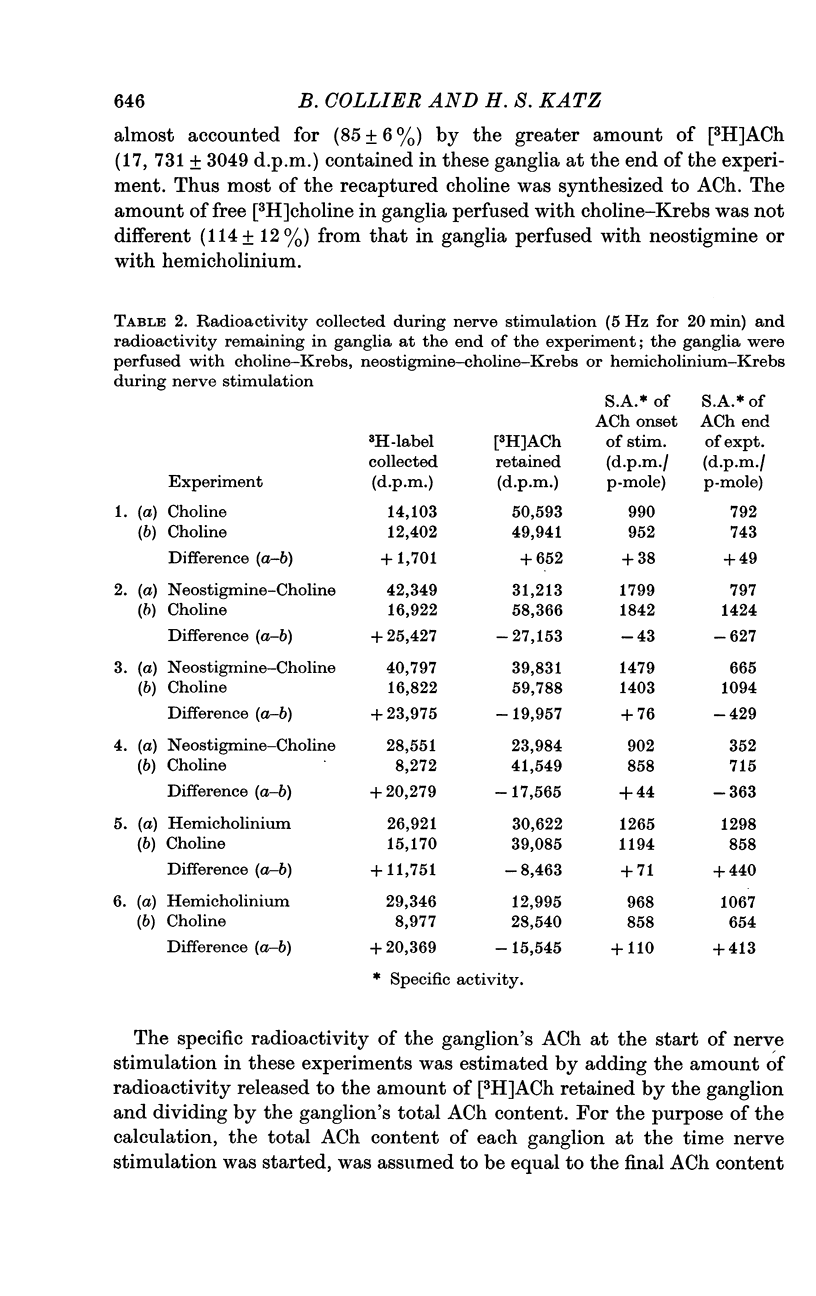
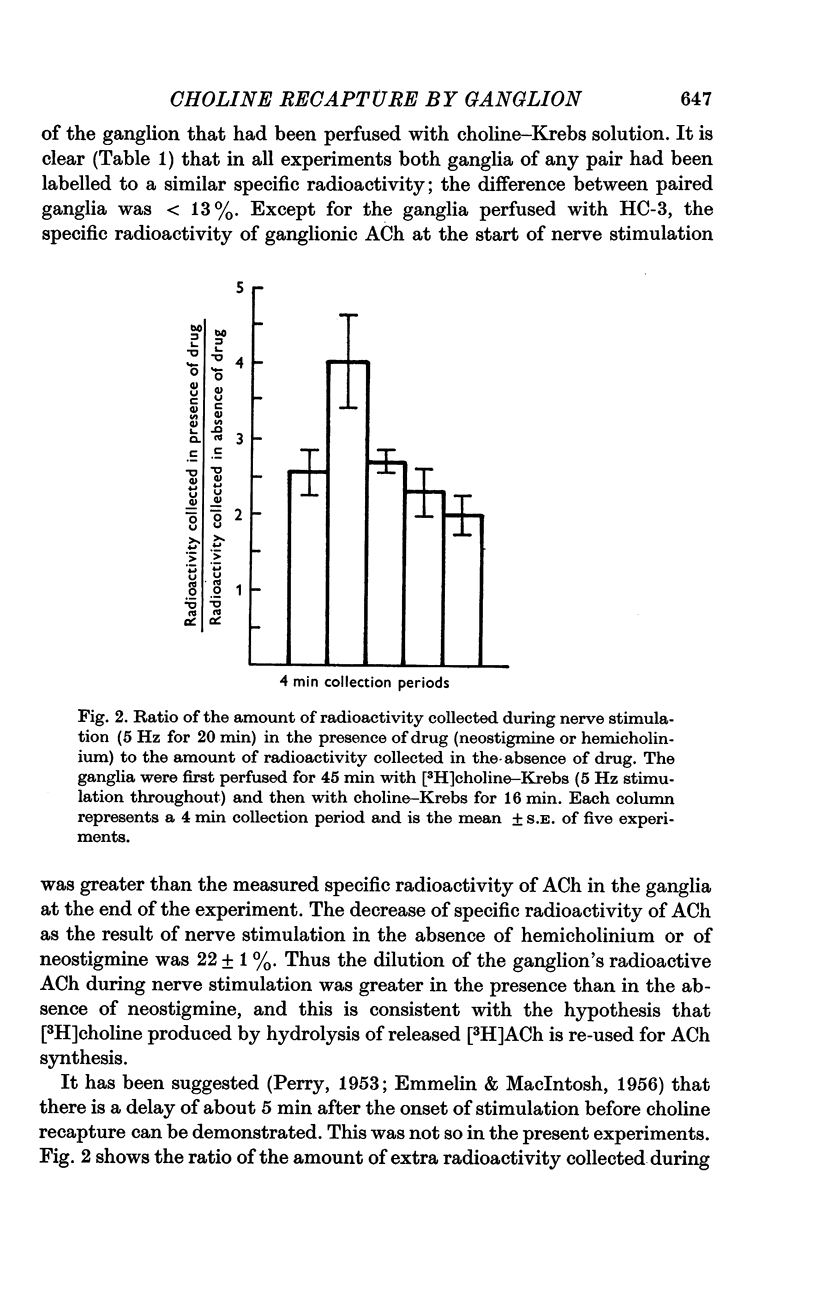
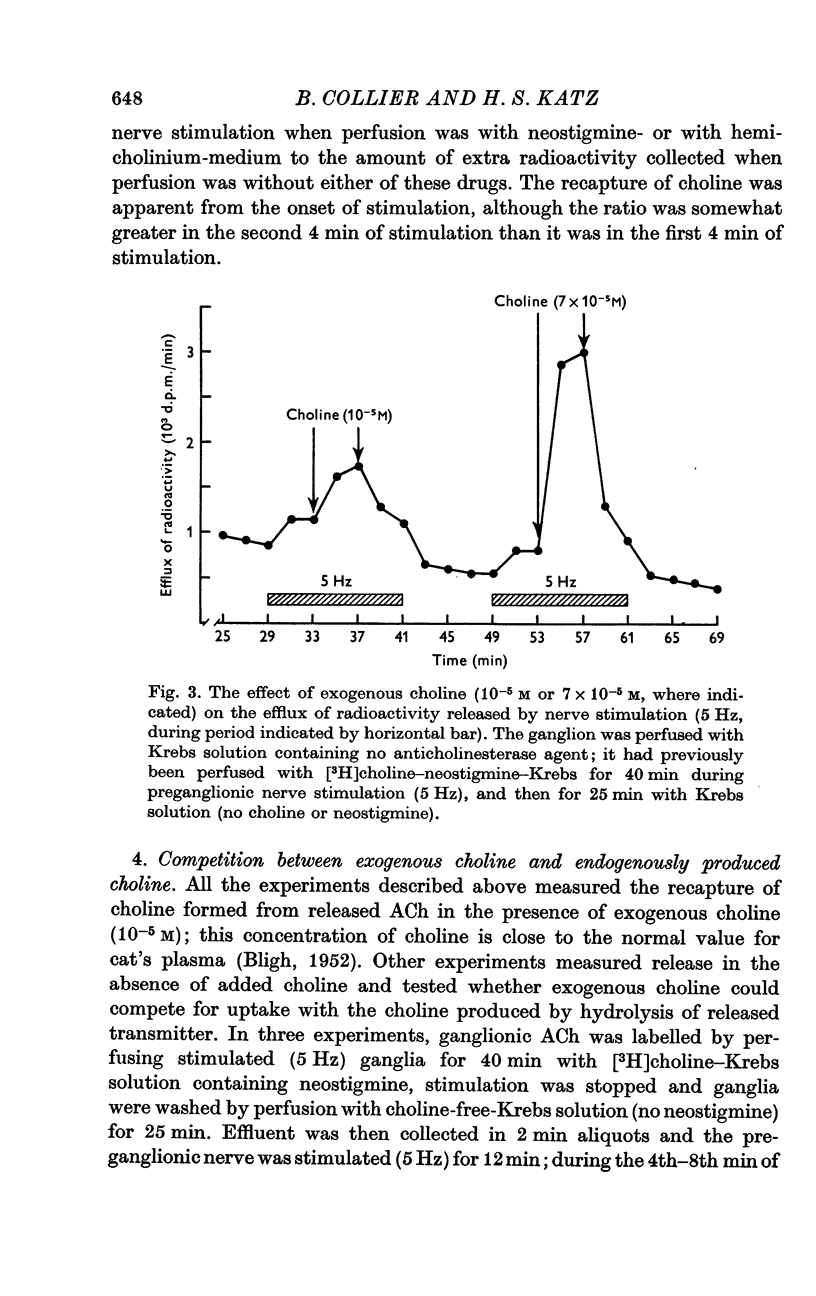
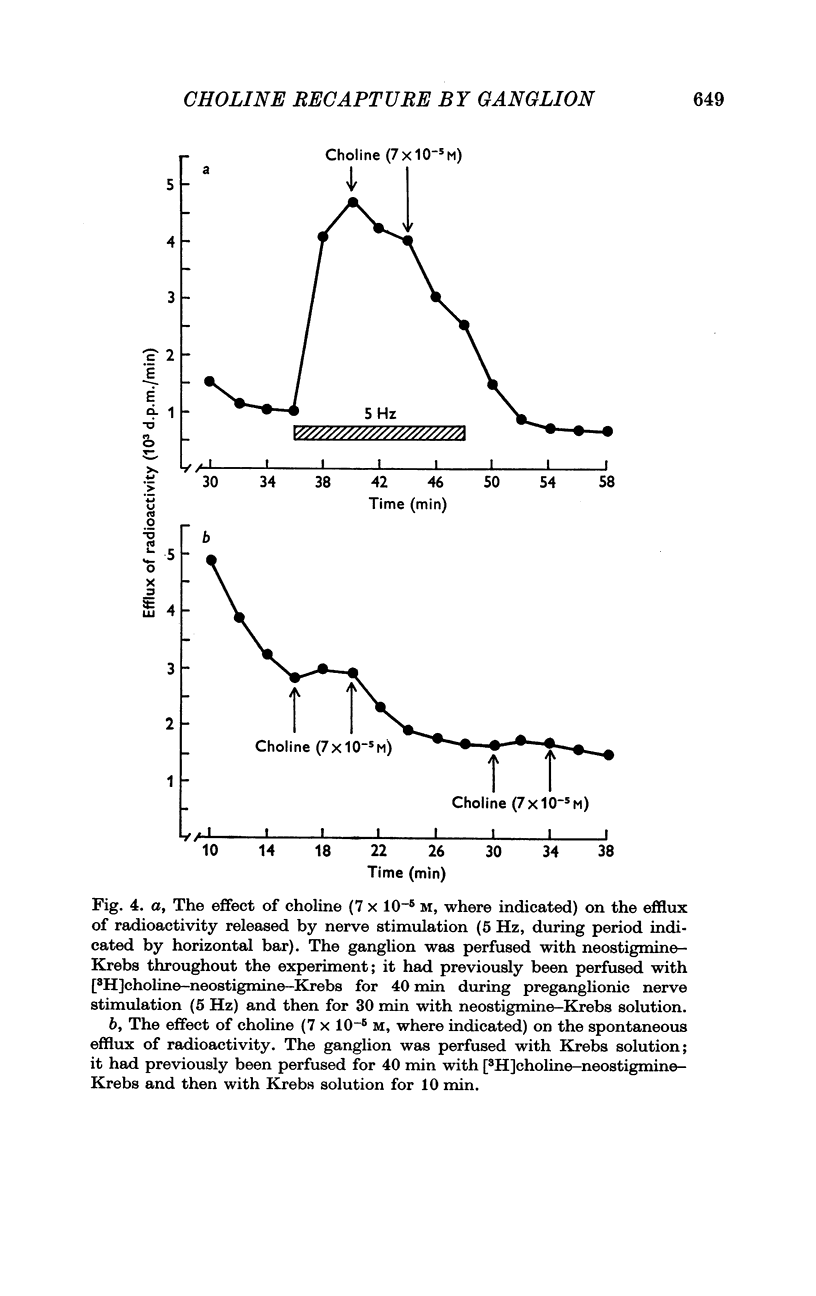
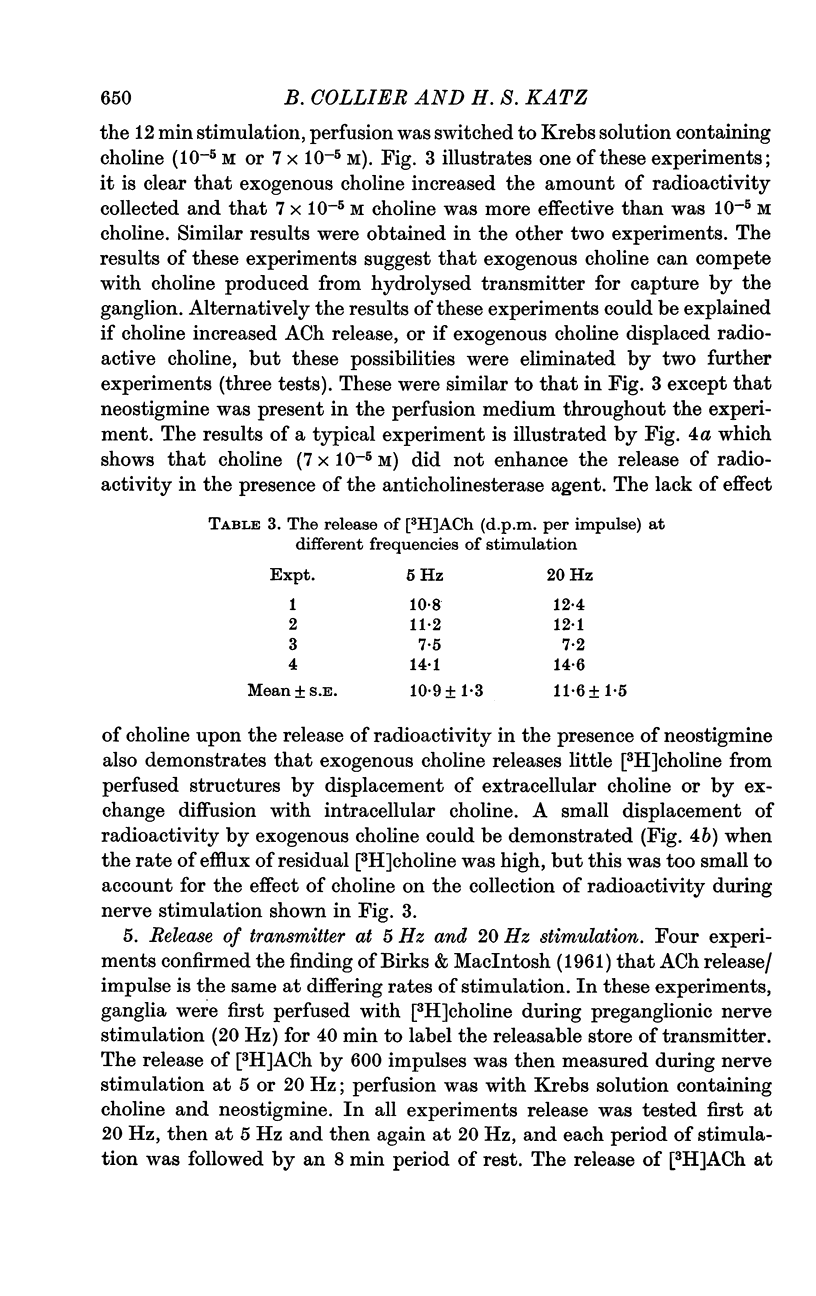


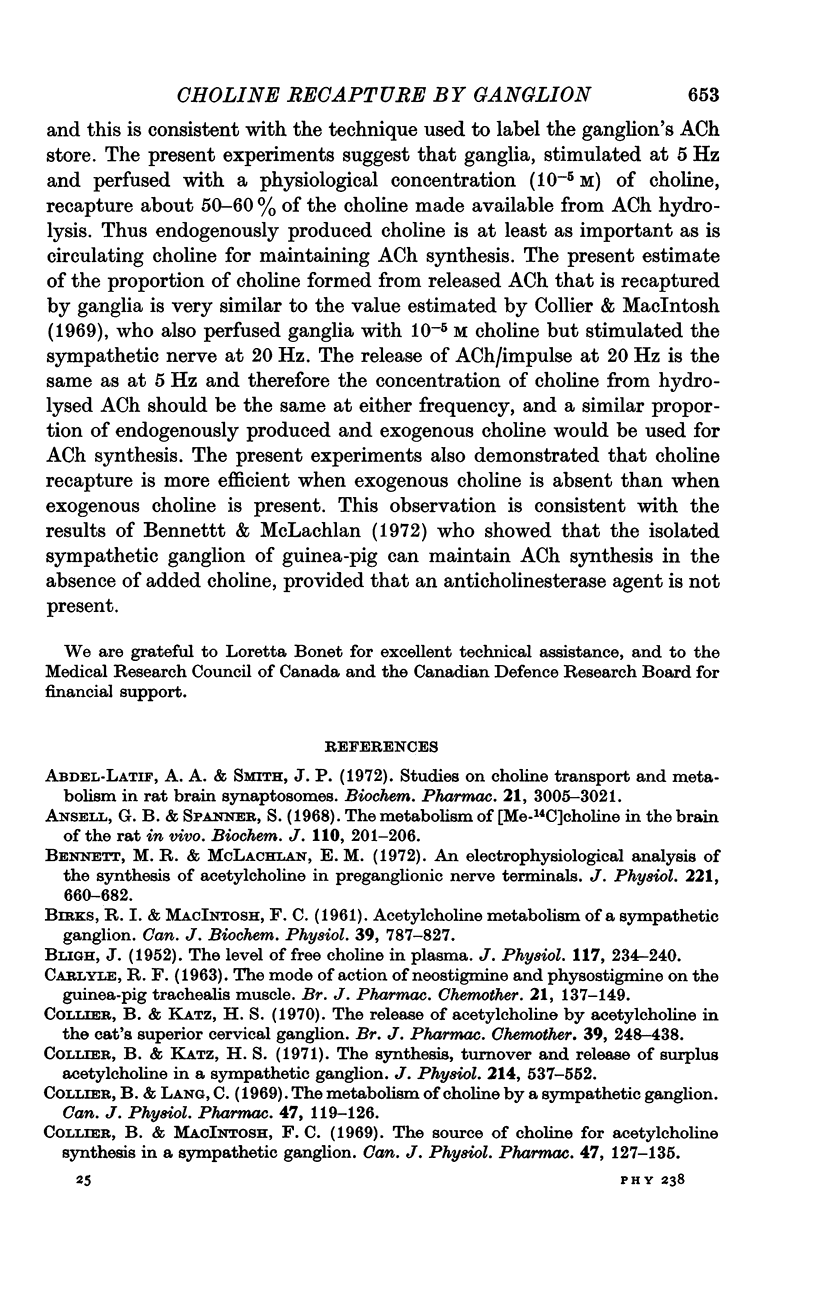
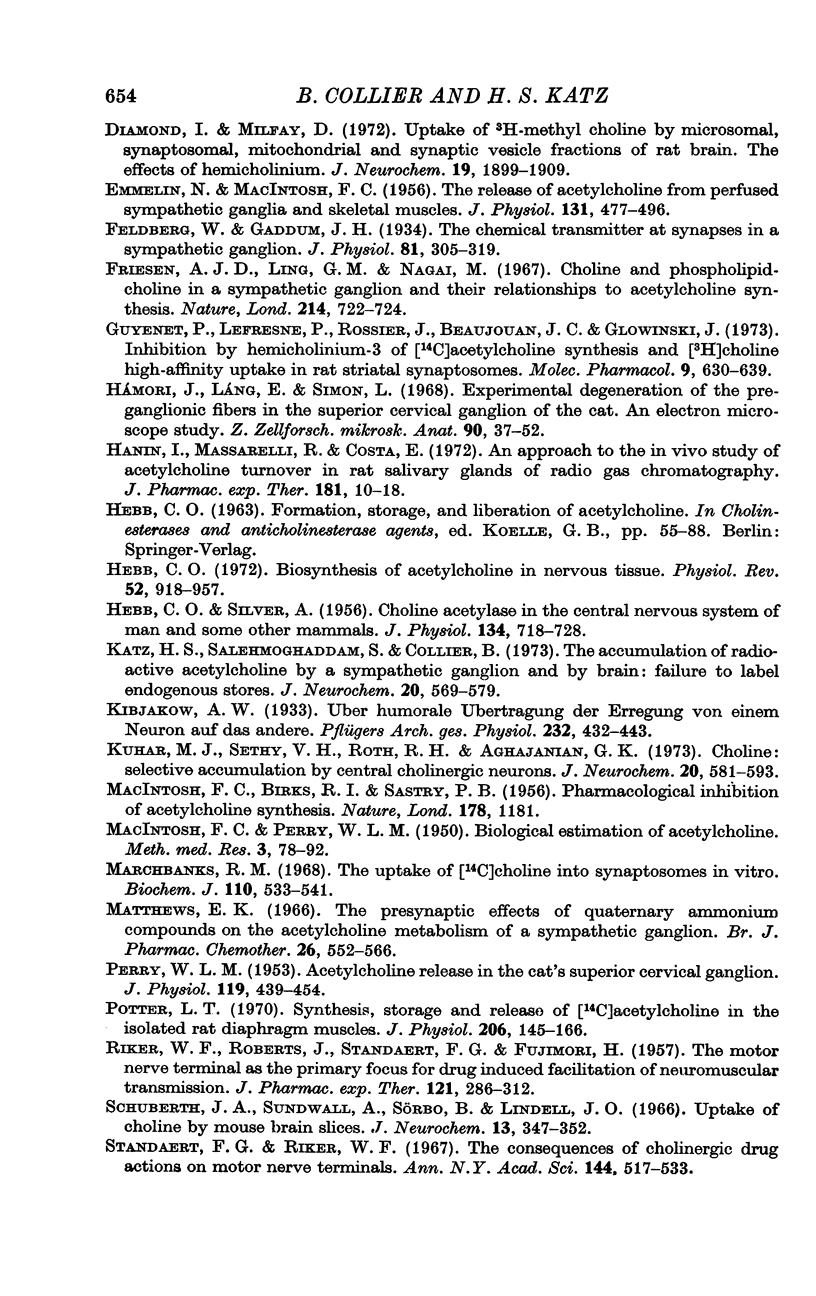
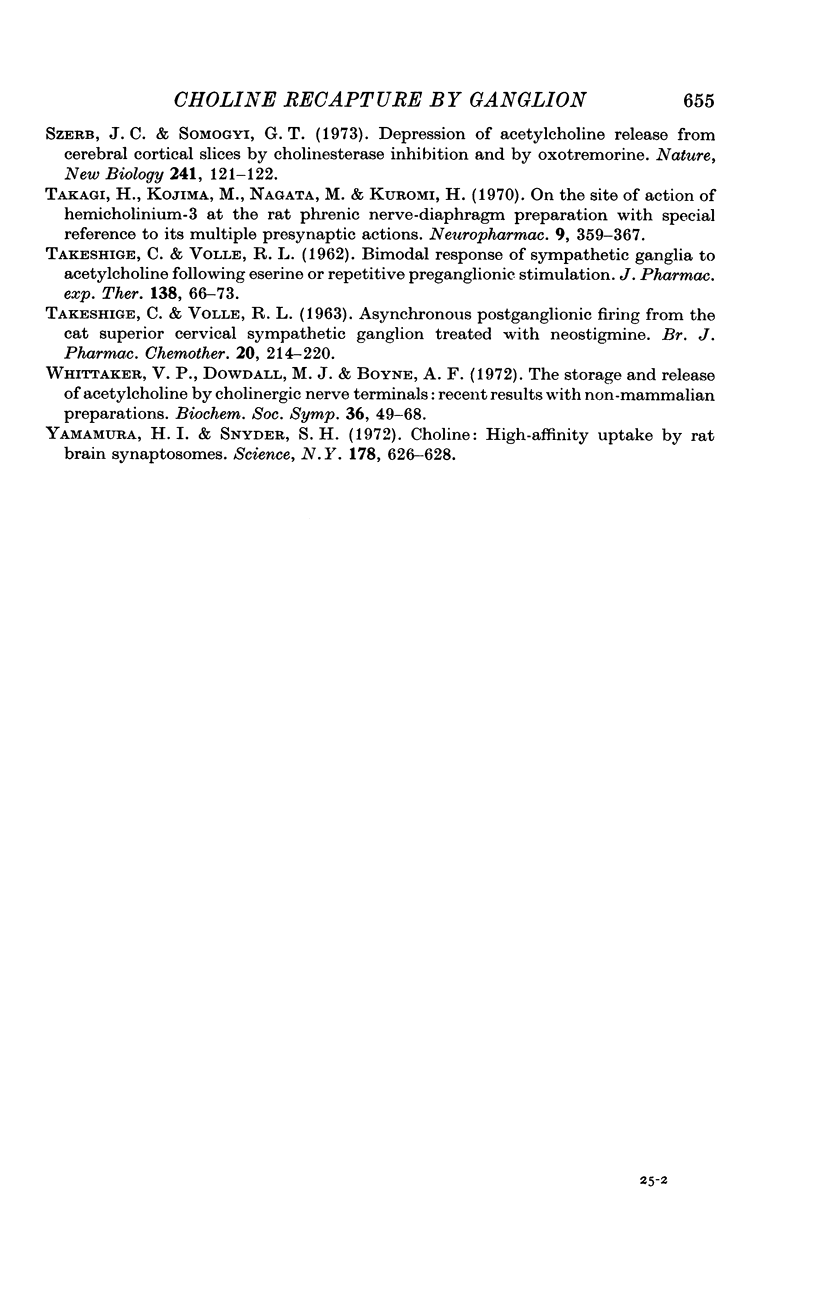
Selected References
These references are in PubMed. This may not be the complete list of references from this article.
- Abdel-Latif A. A., Smith J. P. Studies on choline transport and metabolism in rat brain synaptosomes. Biochem Pharmacol. 1972 Nov 15;21(22):3005–3021. doi: 10.1016/0006-2952(72)90193-1. [DOI] [PubMed] [Google Scholar]
- Ansell G. B., Spanner S. The metabolism of [Me-14C]choline in the brain of the rat in vivo. Biochem J. 1968 Nov;110(2):201–206. doi: 10.1042/bj1100201. [DOI] [PMC free article] [PubMed] [Google Scholar]
- BIRKS R. I., MACINTOSH F. C., SASTRY P. B. Pharmacological inhibition of acetylcholine synthesis. Nature. 1956 Nov 24;178(4543):1181–1181. doi: 10.1038/1781181a0. [DOI] [PubMed] [Google Scholar]
- BLIGH J. The level of free choline in plasma. J Physiol. 1952 Jun;117(2):234–240. doi: 10.1113/jphysiol.1952.sp004743. [DOI] [PMC free article] [PubMed] [Google Scholar]
- Bennett M. R., McLachlan E. M. An electrophysiological analysis of the synthesis of acetylcholine in preganglionic nerve terminals. J Physiol. 1972 Mar;221(3):669–682. doi: 10.1113/jphysiol.1972.sp009775. [DOI] [PMC free article] [PubMed] [Google Scholar]
- CARLYLE R. F. THE MODE OF ACTION OF NEOSTIGMINE AND PHYSOSTIGMINE ON THE GUINEA-PIG TRACHEALIS MUSCLE. Br J Pharmacol Chemother. 1963 Aug;21:137–149. doi: 10.1111/j.1476-5381.1963.tb01509.x. [DOI] [PMC free article] [PubMed] [Google Scholar]
- Collier B., Katz H. S. The release of acetylcholine by acetylcholine in the cat's superior cervical ganglion. Br J Pharmacol. 1970 Jun;39(2):428–438. doi: 10.1111/j.1476-5381.1970.tb12905.x. [DOI] [PMC free article] [PubMed] [Google Scholar]
- Collier B., Katz H. S. The synthesis, turnover and release of surplus acetylcholine in a sympathetic ganglion. J Physiol. 1971 May;214(3):537–552. doi: 10.1113/jphysiol.1971.sp009447. [DOI] [PMC free article] [PubMed] [Google Scholar]
- Collier B., Lang C. The metabolism of choline by a sympathetic ganglion. Can J Physiol Pharmacol. 1969 Feb;47(2):119–126. doi: 10.1139/y69-022. [DOI] [PubMed] [Google Scholar]
- Diamond I., Milfay D. Uptake of ( 3 H-methyl)choline by microsomal, synaptosomal, mitochondrial and synaptic vesicle fractions of rat brain. The effects of hemicholinium. J Neurochem. 1972 Aug;19(8):1899–1909. doi: 10.1111/j.1471-4159.1972.tb01478.x. [DOI] [PubMed] [Google Scholar]
- EMMELIN N., MACINTOSH F. C. The release of acetylcholine from perfused sympathetic ganglia and skeletal muscles. J Physiol. 1956 Feb 28;131(2):477–496. doi: 10.1113/jphysiol.1956.sp005477. [DOI] [PMC free article] [PubMed] [Google Scholar]
- Feldberg W., Gaddum J. H. The chemical transmitter at synapses in a sympathetic ganglion. J Physiol. 1934 Jun 9;81(3):305–319. doi: 10.1113/jphysiol.1934.sp003137. [DOI] [PMC free article] [PubMed] [Google Scholar]
- Friesen A. J., Ling G. M., Nagai M. Choline and phospholipid-choline in a sympathetic ganglion and their relationship to acetylcholine synthesis. Nature. 1967 May 13;214(5089):722–724. doi: 10.1038/214722a0. [DOI] [PubMed] [Google Scholar]
- Guyenet P., Lefresne P., Rossier J., Beaujouan J. C., Glowinski J. Inhibition by hemicholinium-3 of (14C)acetylcholine synthesis and (3H)choline high-affinity uptake in rat striatal synaptosomes. Mol Pharmacol. 1973 Sep;9(5):630–639. [PubMed] [Google Scholar]
- HEBB C. O., SILVER A. Choline acetylase in the central nervous system of man and some other mammals. J Physiol. 1956 Dec 28;134(3):718–728. doi: 10.1113/jphysiol.1956.sp005678. [DOI] [PMC free article] [PubMed] [Google Scholar]
- Hanin I., Massarelli R., Costa E. An approach to the in vivo study of acetylcholine turnover in rat salivary glands by radio gas chromatography. J Pharmacol Exp Ther. 1972 Apr;181(1):10–18. [PubMed] [Google Scholar]
- Hebb C. Biosynthesis of acetylcholine in nervous tissue. Physiol Rev. 1972 Oct;52(4):918–957. doi: 10.1152/physrev.1972.52.4.918. [DOI] [PubMed] [Google Scholar]
- Hámori J., Láng E., Simon L. Experimental degeneration of the preganglionic fibers in the superior cervical ganglion of the cat. An electron microscope study. Z Zellforsch Mikrosk Anat. 1968;90(1):37–52. doi: 10.1007/BF00496701. [DOI] [PubMed] [Google Scholar]
- Katz H. S., Salehmoghaddam S., Collier B. The accumulation of radioactive acetylcholine by a sympathetic ganglion and by brain: failure to label endogenous stores. J Neurochem. 1973 Feb;20(2):569–579. doi: 10.1111/j.1471-4159.1973.tb12156.x. [DOI] [PubMed] [Google Scholar]
- Kuhar M. J., Sethy V. H., Roth R. H., Aghajanian G. K. Choline: selective accumulation by central cholinergic neurons. J Neurochem. 1973 Feb;20(2):581–593. doi: 10.1111/j.1471-4159.1973.tb12157.x. [DOI] [PubMed] [Google Scholar]
- Marchbanks R. M. The uptake of [14C] choline into synaptosomes in vitro. Biochem J. 1968 Dec;110(3):533–541. doi: 10.1042/bj1100533. [DOI] [PMC free article] [PubMed] [Google Scholar]
- Matthews E. K. The presynaptic effects of quaternary ammonium compounds on the acetylcholine metabolism of a sympathetic ganglion. Br J Pharmacol Chemother. 1966 Mar;26(3):552–566. doi: 10.1111/j.1476-5381.1966.tb01836.x. [DOI] [PMC free article] [PubMed] [Google Scholar]
- PERRY W. L. M. Acetylcholine release in the cat's superior cervical ganglion. J Physiol. 1953 Mar;119(4):439–454. doi: 10.1113/jphysiol.1953.sp004858. [DOI] [PMC free article] [PubMed] [Google Scholar]
- Potter L. T. Synthesis, storage and release of [14C]acetylcholine in isolated rat diaphragm muscles. J Physiol. 1970 Jan;206(1):145–166. doi: 10.1113/jphysiol.1970.sp009003. [DOI] [PMC free article] [PubMed] [Google Scholar]
- RIKER W. F., Jr, ROBERTS J., STANDAERT F. G., FUJIMORI H. The motor nerve terminal as the primary focus for drug-in-duced facilitation of neuromuscular transmission. J Pharmacol Exp Ther. 1957 Nov;121(3):286–312. [PubMed] [Google Scholar]
- Szerb J. C., Somogyi G. T. Depression of acetylcholine release from cerebral cortical slices by cholinesterase inhibition and by oxotremorine. Nat New Biol. 1973 Jan 24;241(108):121–122. doi: 10.1038/newbio241121a0. [DOI] [PubMed] [Google Scholar]
- TAKESHIGE C., VOLLE R. L. Asynchronous postganglionic firing from the cat superior cervical sympathetic ganglion treated with neostigmine. Br J Pharmacol Chemother. 1963 Feb;20:214–220. doi: 10.1111/j.1476-5381.1963.tb01311.x. [DOI] [PMC free article] [PubMed] [Google Scholar]
- TAKESHIGE C., VOLLE R. L. Bimodal response of sympathetic ganglia to acetylcholine following eserine or repetitive preganglionic stimulation. J Pharmacol Exp Ther. 1962 Oct;138:66–73. [PubMed] [Google Scholar]
- Takagi H., Kojima M., Nagata M., Kuromi H. On the site of action of hemicholinium-3 at the rat phrenic nerve-diaphragm preparation with special reference to its multiple presynaptic actions. Neuropharmacology. 1970 Jul;9(4):359–367. doi: 10.1016/0028-3908(70)90033-x. [DOI] [PubMed] [Google Scholar]
- Whittaker V. P., Dowdall M. J., Boyne A. F. The storage and release of acetylcholine by cholinergic nerve terminals: recent results with non-mammalian preparations. Biochem Soc Symp. 1972;(36):49–68. [PubMed] [Google Scholar]
- Yamamura H. I., Snyder S. H. Choline: high-affinity uptake by rat brain synaptosomes. Science. 1972 Nov 10;178(4061):626–628. doi: 10.1126/science.178.4061.626. [DOI] [PubMed] [Google Scholar]


